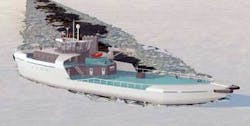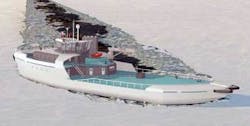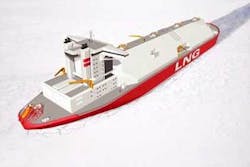Evolving LNG vessel designs and operating strategies could help industry players tap Russia’s huge Arctic resources by conquering the area’s extremely cold winters and icebound seas.
Until now, ice has not been a significant factor in vessel design and operation. Even Russia’s Sakhalin II venture and the Snøhvit LNG project in Norway’s Barents Sea have required little adjustment for ice. But all this is likely to change if projects proposed for Russia’s Arctic coast and the Baltic Sea come to fruition.
Projects
Ice is not, surprisingly, a serious issue at Snøhvit. Although the Melkøya Island loading port is above the Arctic Circle, shipping operations remain ice-free all year thanks to the Gulf Stream’s moderating influence.
But the region’s subzero temperatures require topsides winterization for Snøhvit’s ships, including an enclosed bridge, heating on various parts of the deck and passageways, steam outlets for deicing, ballast-tank heating, additional winter clothing and protection for crew, and use of low-temperature-grade lubrication oil. The project’s four ships were delivered earlier this year.
Sakhalin II has had to adopt minimal ice-class shipping to cope with Prigorodnoye port’s 90-day ice season and the drifting ice pushed into Aniva Bay from the surrounding seas. The Sakhalin II ships still perform efficiently in open water, where they’ll spend most of their lives, but have the strengthened icebelt, rudder, propeller, and screwshaft plus the increased engine power required to navigate in icy waters. The vessels were all ordered in 2004 for delivery between 2007 and 2009.
More stringent ice-class requirements are a feature of several upcoming LNG projects in Russia, including proposals targeting the Yamal Peninsula on the country’s Arctic coast and along the Baltic Sea. Shipping in these areas imposes far more rigorous requirements on vessels than anything experienced to date, spurring increased ice-class design activity among ship designers and the various classification societies. Several combinations of ice-class shipping and icebreaker assistance are now in the works for such locations as Yamal.
The least radical approach for Yamal involves using ice-class ships escorted by two icebreakers that carve a channel wide enough for safe passage through the Kara Sea’s winter ice sheet. This is the simplest option where shipping traffic is sufficiently frequent to keep the channel open. Another alternative under development by Finland’s Aker Arctic Technology is an oblique-shaped icebreaker that would turn sideways in ice conditions to create a sufficiently wide shipping channel with a single vessel (Fig. 1).
A third alternative under development at Aker Arctic is a “double acting” LNG tanker (DAT), a vessel with a regularly shaped bow plus a stern modified for icebreaking service (Fig. 2). This design allows the vessel to sail efficiently in open waters yet act as its own icebreaker when sailing astern. The DAT design has already been applied to oil tankers for Arctic conditions but remains in conceptual design for LNG transport.
DATs use a robust azipod-mounted propulsion system that functions as a bow propeller when the ship is running astern in icebreaking conditions, creating downward pressure on ice, breaking up the ice rubble, and flushing ice away from the ship’s hull. The design would use the same power as a normal open-water vessel, whereas escorted ice-class travel requires additional engine power to cope with ice transit’s higher resistance. Other differences from standard open-water ships include stronger gearboxes for screw shaft drives to withstand repeated shocks, or diesel-electric propulsion to provide the high torque and low revolutions needed to prevent the vessel becoming stuck in the ice.
Standards
An important step towards the realization of these Arctic shipping alternatives hinges on the classification societies’ setting appropriate standards for the vessels.
All current classes draw a distinction between first-year and multiyear ice conditions. First-year ice represents a single winter’s growth of about 0.3-2.0 m thickness. By comparison, multiyear ice has survived at least 2 summer’s melt, is considerably stronger than single-year ice, and can be up to 3 m thick. First-year ice is common in the Baltic Sea, while multiyear ice is more of an issue for Arctic navigation.
Currently, each classification society has its own set of nominal ice classes, explaining the conditions in which the vessel can operate.
Lloyd’s Register has five first-year ice classes and four multiyear ice classes. The Swedish-Finnish rules, on the other hand, note four different classes, intended mainly for ships navigating in the Baltic Sea. The International Association of Classification Societies has suggested a series of Polar Class notations that tries to merge the different classifications, with the two highest classes coinciding with the two highest Swedish-Finnish rules.
Like all Arctic endeavors, establishing an ice-class shipping operation is destined to be expensive. At the very least, these ships will require significant changes from standard LNG vessel design, extensive use of low-temperature steels, and significant winterization modifications.
One alternative under consideration for Yamal involves use of ice-class ships as shuttles to the ice-free port at Murmansk, then transfer of the cargo to conventional ships for the remainder of the voyage. This shuttle operation, however, would either require establishing an onshore transfer and storage facility or ship-to-ship transfers. Both of these alternatives involve additional capital costs and cargo boil-off losses, while an STS operation has yet to be approved for commercial use by the Society of International Gas Tanker & Terminal Operators.
Based on an article in LNG in World Markets, May 2006, Poten & Partners Inc., New York (www.poten.com).




